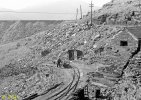decauville1126
Active Member
Phil - re:Manod pm sent
Be interesting to see how well Dapol manage this livery ?Rob, I'm assuming in weathering your 7754 that you were aiming for something like its condition while working for the NCB. However you appear to have used a light brown sandy/rusty colour for the cab and tank sides which wouldn't really be appropriate. Weathering on the upperworks (above the footplate) would be either out of the chimney - soot, dark grey in colour - or from the colliery environment - coal dust, dark grey/black in colour. Unfortunately I didn't take any colour photos of 7754 at Mountain Ash, but several photos are available on the internet of the loco at the Blaenserchan Line and at Mountain Ash.
The type of weathering typical on a colliery locomotive is illustrated on the Peckett SIR GOMER at Mountain Ash, the only sandy/rusty colour is a small patch on the bottom of the tank above the sandbox filler lid where some spilled sand has stuck and on the rear tank support caused by a leaking connection at the rear of the injector, otherwise all the weathering above the footplate is dark grey.
View attachment 156666
WHISTON at Bold Colliery also has similar dark grey weathering although not quite as bad as SIR GOMER.
View attachment 156667
However, contrary to what most people think, working NCB steam locos were not always covered in filth - 3 years after the last photo WHISTON was again photographed at Bold after a repaint and probably a different crew who took a bit more pride in the appearance of their engine, although the white wheel tyres are probably a bit "over the top" !
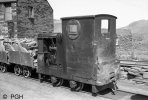
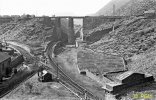
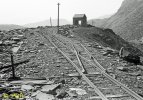
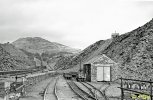
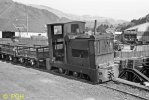
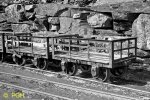
View attachment 160328
The view from above the tunnel mouth of the BR Conwy Valley Line at Blaenau Ffestiniog in March 1965. Prominent is the Oakeley Quarry viaduct which accessed a large tip on the left. The viaduct was built by the Welsh Slate Company, one of the three constituents of the Oakeley Quarry, when they had run out of available land on their side of the Afon Barlwyd for waste tipping. A slate mill was later built on top of the tip. The BR line passes under one span of the viaduct on a bridge over the Afon Barlwyd, while the former course of the Festiniog Railway passed under the other span, then continued to pass under the BR line to the bottom left hand corner of the photo to join an incline from Llechwedd Quarry. The siding off the BR line to the left served the Llechwedd Quarry wharf where slate was loaded into BR wagons or road transport. In the centre of the photo is the site of the sidings which once served the Oakeley Quarry, the entry point being partly within the tunnel. In 1933 Oakeley Quarry built a new narrow gauge line directly into the Blaenau Ffestiniog North Station goods yard, and the sidings at the tunnel mouth were lifted in June 1941. The new line crossed the viaduct then ran along the top of the tip to an incline on the far side, the drumhouse is just visible in the distance above the left hand end of the viaduct. From the foot of the incline the new line paralleled the BR line into the North Station goods yard. The viaduct and tip were removed in a landscaping scheme in the 1970s.
View attachment 160329
LNWR siding diagram showing the arrangements at the tunnel mouth
View attachment 160330
View on top of the viaduct looking back towards the quarry. In the centre of the photo is a line of empty slate wagons at the foot of the incline up to the main office level of the quarry. Just to the right of the incline foot is a small locomotive shed. Straight ahead in line with the viaduct is the entrance to a tunnel which emerged at the other end on the quarry's D Level in Sinc Fawr.
View attachment 160332
View on top of the tip towards the incline drumhouse with a 'half stub' point in the foreground. The BR line is just visible on the right.
View attachment 160333
The foot of the incline with the loco shed on the right.
View attachment 160334
Ruston & Hornsby works no.174139, a 27/32 hp loco supplied new to the quarry in 1935, photographed in the North Station goods yard in March 1965.
View attachment 160335
Braked and unbraked examples of the slate wagons built by the LNWR for their unsuccessful attempt to divert traffic carried by the Festiniog for shipment from Portmadoc to a new wharf built by the LNWR at Deganwy. The wagons were intended to be loaded in the quarries and then carried on standard gauge 'host' wagons to Deganwy where they could be unloaded directly into ships. A total of 250 were built of which 100 were fitted with brakes. They are similar to the Festiniog 2 ton slate wagons but the axleboxes carry the wording "LNW EARLESTOWN" and the solebars carry LMS number plates. The two lugs in the centre of the solebar were part of the arrangement for securing them on the host wagons.
Oakeley Quarry coal wagon no.3 in North Station yard in 1964. Its since been restored and is now on display in the Narrow Gauge Railway Museum at Towyn. Shapeways do a 3D printed version of this wagon in 7mm scale.
Superb pictures of the LNWR slate wagons. If you can read any of the LMS numbers I'd be grateful, please. As you say, 250 were built but the known numbers cover a larger range which is curious, so any more known numbers would be useful!
Mike
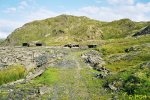
Phil,View attachment 160502
Approaching the quarry along the trackbed. The ruined buildings in the centre of the photo were the workshops and stores, the main adit giving access to the underground workings is out of view behind. To the left are the barracks where the men stayed during the working week and the open area nearer the camera was occupied by the large slate mill. After the quarry was abandoned some small scale working was carried out on the surface from 1949 to 1954, producing slates from slabs extracted from the walls of the main mill and resulting in the destruction of what remained of the mill building.
A closer view of the barracks with a few remaining items that the scrapmen missed - a waste wagon body and set of wheels, and of course the inevitable sheep.
This unremarkable looking hole in the ground was actually the main adit - Level 9, some 740 yards long through which most of the slate produced by the quarry emerged from the underground workings. Wagons were hauled through the adit on a 3 rail track system by an endless rope driven by a waterwheel outside the entrance. Halfway along the tunnel widened to accommodate a passing loop with 4 rails. Trains of about 12 wagons were assembled at each end of the line and attached to the rope by a special wagon with a clamp underneath to grip the rope known as a 'Megryn'. The rope was set in motion and after all the slack had been taken out of the couplings a second Megryn at the rear of the train was then clamped to the cable to avoid any runaways. The trains then ran unattended through the adit passing each other midway at the passing loop. A reconstructed Megryn is on display at the Welsh Highland Heritage Railway's museum in Portmadoc. The incline alongside served the earlier upper levels of the quarry which were abandoned after the underground workings continued below Level 9.
View attachment 160505
The upturned remains of a slab wagon, known locally as a 'sled'.
View attachment 160506
Unusually for a slate quarry, single flanged wheels were used for the internal wagons at Rhosydd. Maybe the 3 rail system with its passing loop in Adit 9 ruled out the usual double flanged wheels.
The quarry closed for production in 1930 but was kept on a care and maintenance basis in case of possible reopening until 1948. During that period the incline and tramway were used only to bring in fuel oil for the pumps draining the underground workings, the wagons loaded with oil being balanced on the incline going up with wagons loaded with waste slate going down. This lasted until 1944 and for the last few years the fuel oil was brought in by road transport via Cwmorthin. In 1948 the pumps were switched off, the underground workings abandoned and most of the track removed.
Rhosydd is well known today by cave explorers with a through route through the underground workings from Croesor Quarry, involving along the way a trip across flooded quarry chambers in a rubber dinghy - I did enjoy exploring old quarry workings, but I think I'd pass on that one !
A detailed history of the quarry by M.J.T.Lewis and J.H.Denton was published by the Cottage Press of Shrewsbury in 1974.
That misty or low cloud image would win photographic competitions Phil. What a capture.
